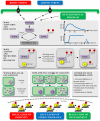Nuclear Signaling of Plant MAPKs
- PMID: 29696029
- PMCID: PMC5905223
- DOI: 10.3389/fpls.2018.00469
Nuclear Signaling of Plant MAPKs
Abstract
Mitogen-activated protein kinases (MAPKs) are conserved protein kinases in eukaryotes that establish signaling modules where MAPK kinase kinases (MAPKKKs) activate MAPK kinases (MAPKKs) which in turn activate MAPKs. In plants, they are involved in the signaling of multiple environmental stresses and developmental programs. MAPKs phosphorylate their substrates and this post-translational modification (PTM) contributes to the regulation of proteins. PTMs may indeed modify the activity, subcellular localization, stability or trans-interactions of modified proteins. Plant MAPKs usually localize to the cytosol and/or nucleus, and in some instances they may also translocate from the cytosol to the nucleus. Upon the detection of environmental changes at the cell surface, MAPKs participate in the signal transduction to the nucleus, allowing an adequate transcriptional reprogramming. The identification of plant MAPK substrates largely contributed to a better understanding of the underlying signaling mechanisms. In this review, we highlight the nuclear signaling of plant MAPKs. We discuss the activation, regulation and activity of plant MAPKs, as well as their nuclear re-localization. We also describe and discuss known nuclear substrates of plant MAPKs in the context of biotic stress, abiotic stress and development and consider future research directions in the field of plant MAPKs.
Keywords: abiotic stress; biotic stress; development; mitogen-activated protein kinase; nucleus; phosphorylation; signaling.
Figures

Similar articles
-
Harnessing the role of mitogen-activated protein kinases against abiotic stresses in plants.Front Plant Sci. 2023 Feb 24;14:932923. doi: 10.3389/fpls.2023.932923. eCollection 2023. Front Plant Sci. 2023. PMID: 36909407 Free PMC article. Review.
-
Mitogen-activated protein kinase cascades in Vitis vinifera.Front Plant Sci. 2015 Jul 22;6:556. doi: 10.3389/fpls.2015.00556. eCollection 2015. Front Plant Sci. 2015. PMID: 26257761 Free PMC article.
-
Cellular reprogramming through mitogen-activated protein kinases.Front Plant Sci. 2015 Oct 29;6:940. doi: 10.3389/fpls.2015.00940. eCollection 2015. Front Plant Sci. 2015. PMID: 26579181 Free PMC article. Review.
-
Cell and Developmental Biology of Plant Mitogen-Activated Protein Kinases.Annu Rev Plant Biol. 2018 Apr 29;69:237-265. doi: 10.1146/annurev-arplant-042817-040314. Epub 2018 Feb 28. Annu Rev Plant Biol. 2018. PMID: 29489398 Review.
-
Convergence and divergence of stress-induced mitogen-activated protein kinase signaling pathways at the level of two distinct mitogen-activated protein kinase kinases.Plant Cell. 2002 Mar;14(3):703-11. Plant Cell. 2002. PMID: 11910015 Free PMC article.
Cited by
-
OsMKK1 is a novel element that positively regulates the Xa21-mediated resistance response to Xanthomonas oryzae pv. oryzae in rice.Plant Cell Rep. 2024 Jan 10;43(2):31. doi: 10.1007/s00299-023-03085-8. Plant Cell Rep. 2024. PMID: 38195905
-
The immunity priming effect of the Arabidopsis phyllosphere resident yeast Protomyces arabidopsidicola strain C29.Front Microbiol. 2022 Sep 2;13:956018. doi: 10.3389/fmicb.2022.956018. eCollection 2022. Front Microbiol. 2022. PMID: 36118213 Free PMC article.
-
Harnessing the role of mitogen-activated protein kinases against abiotic stresses in plants.Front Plant Sci. 2023 Feb 24;14:932923. doi: 10.3389/fpls.2023.932923. eCollection 2023. Front Plant Sci. 2023. PMID: 36909407 Free PMC article. Review.
-
Early Root Transcriptomic Changes in Wheat Seedlings Colonized by Trichoderma harzianum Under Different Inorganic Nitrogen Supplies.Front Microbiol. 2019 Oct 25;10:2444. doi: 10.3389/fmicb.2019.02444. eCollection 2019. Front Microbiol. 2019. PMID: 31749777 Free PMC article.
-
Advances in understanding Norway spruce natural resistance to needle bladder rust infection: transcriptional and secondary metabolites profiling.BMC Genomics. 2022 Jun 13;23(1):435. doi: 10.1186/s12864-022-08661-y. BMC Genomics. 2022. PMID: 35692040 Free PMC article.
References
-
- Ahlfors R., Macioszek V., Rudd J., Brosché M., Schlichting R., Scheel D., et al. . (2004). Stress hormone-independent activation and nuclear translocation of mitogen-activated protein kinases in Arabidopsis thaliana during ozone exposure. Plant J. 40, 512–522. 10.1111/j.1365-313X.2004.02229.x - DOI - PubMed
Publication types
LinkOut - more resources
Full Text Sources
Other Literature Sources
Miscellaneous

